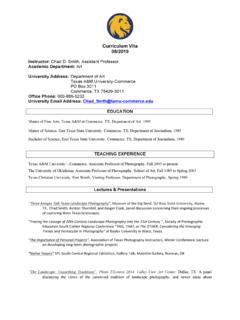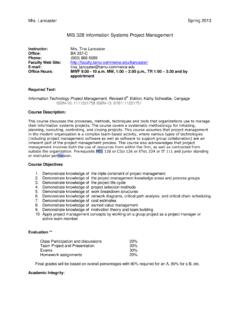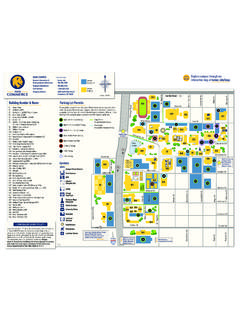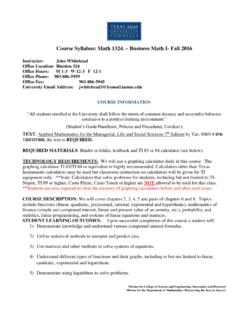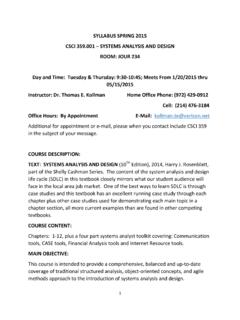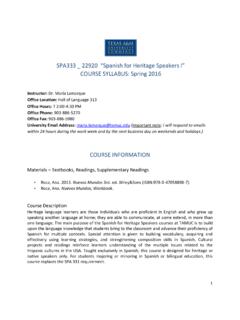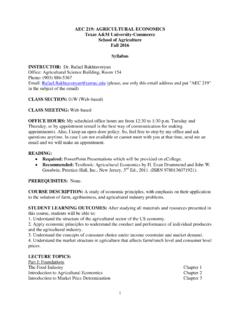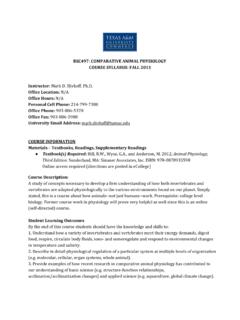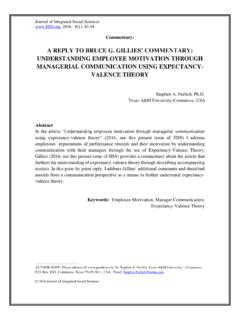Transcription of Understanding+Your+Talents+&+Strengths+
1 Institutional Diversity and Equity understanding your Talents & Strengths Management Development Mee9ng September 28, 2012 Edward W. Romero, Chief Diversity Officer and Director of Equal Opportunity Cer9fied Strengths Advocate Strategic | Responsibility | Delibera9ve | Restora9ve | Futuris9c Institutional Diversity and Equity Background/History of Strengths Become aware of your talents and your poten9al for strengths. Verbalize your themes. Define your signature themes and beWer understand those around you (colleagues). Focus on who you are and what you have not on what you don t have! Strengths Based Leadership Strengths Session Goals Institutional Diversity and Equity Background/History Rooted in more than 40 years of research.
2 Over 7 million people have taken the Cliaon StrengthsFinder online assessment. Was developed with the premise of studying what is right with people (posi9ve psychology). In 1998, the Father of Strengths Psychology, Donald O. Cliaon, (1924- 2003), along with Tom Rath and a team of scien9sts at Gallup created the online StrengthsFinder assessment. In 2004, the assessment's name was formally changed to "Cliaon StrengthsFinder" in honor of its chief designer. In 2007, Gallup scien9sts released a new edi9on of the assessment, program, and website, dubbed StrengthsFinder Institutional Diversity and Equity Strengths Philosophy and Uses Individuals are able to gain far more when they expend effort to build on their greatest talents than when they spend a comparable amount of effort to remediate their weaknesses.
3 Used for understanding individuals and groups in a variety of se#ngs Employees Execu9ve teams Students Family Personal and Professional Development Available in over 20 languages Modifiable for individuals with disabili9es Reading level is grade 10 or higher Institutional Diversity and Equity Six Principles of Human Nature and Behavior Using Strengths 1. You have a group of talents within you. 2. your greatest talents hold the key to high achievement, success, and progress at levels of personal excellence. 3. Becoming aware of your talents builds confidence and provides a basis for achievement. 4. Learning how to develop and apply strengths will improve your levels of achievement.
4 5. Each of your talents can be applied in many areas including rela9onships, learning, academics, leadership, service, and careers. 6. As you develop and apply strengths, your achievements will increase and you will experience greater and more frequent successes. Institutional Diversity and Equity Strengths Tes9ng Subjected to repeated psychometric scru9ny by its developers using the Standards for Educa9onal and Psychological Tes9ng American Educa9onal Research Associa9on American Psychological Associa9on Na9onal Council on Measurement in Educa9on Researchers inside and outside Gallup have contributed valida9on and reliability of the instrument. Studies included are: Confirmatory Studies (Psychometric Proper9es) Reliability Studies (Internal Consistency & Test- Retest Reliability) Validity Studies (Content, Construct, & Criterion- Related Validity) U9lity Studies (Employee Engagement, Employee Turnover, Produc9vity, & Profitability) NOTE: This instrument is NOT intended for use of employee selec9on or mental health screening.
5 Given that CSF feedback is provided to foster intrapersonal development, comparisons across profiles of individuals are discouraged. Institutional Diversity and Equity Cliaon StrengthsFinder The structure of talent measured does not vary across cultures and demographics. Iden9fies areas where the greatest poten9al for strength development exists. Is used as a star9ng point for self- discovery in strengths- based development programs. Successful strength - based development results in desired behavioral change. Relates to various posi9ve outcomes, employee engagement and produc9vity. Is grounded in research and has adequate internal consistency, stability, validity, and cross- cultural applicability. Institutional Diversity and Equity Improving your Life Using a strengths- based approach has shown to: 1.
6 Help people make beWer choices in their life; 2. Help improve performance; 3. Increases produc9vity; 4. Increases self- confidence; 5. Improves employee morale; 6. Improve employees engagement at work; and 7. Assist employees feel valued for their contribu9ons. Institutional Diversity and Equity One thing that is very important to you. Something at which you excel One challenge Focus on You Focus on You 9 Institutional Diversity and Equity A strength is the ability to provide consistent, near- perfect performance in a given ac9vity. Talents are naturally recurring pa=erns of thought, feeling, or behavior that can be produc9vely applied. The key to building a strength is to first iden9fy your dominant theme of talent , then to discover your specific talents within those themes, and to lastly refine them with knowledge and skills.
7 Cliaon & Hodges strength , talent , and Theme Institutional Diversity and Equity strength : The ability to provide consistent, near- perfect performance in a given ac9vity. strength = talent + Knowledge + Skills Iden9fy your talents, add knowledge and skills to build upon your strengths. strength Formula Institutional Diversity and Equity MBTI Measures preferred modes of psychological processing; Provides informa9on about how an individual experiences and makes sense of his/her surroundings. Cli-on StrengthsFinder Measures talent that generates performance; Provides insights into recurring paWerns of thought, feeling, and behavior that can be produc9vely applied for op9mal performance and success.
8 Myers- Briggs Type Indicator (MBTI) and Cliaon StrengthsFinder Primary Difference: They are designed to measure different dimensions of an individual Gallup Senior Scien9st, Phil Stone, psychology professor at Harvard Both are self assessment tools Categorizing people can be challenging and ar9ficial at 9mes PaWerns of thought and behavior are unique to individuals Can be used to foster discussion and awareness of preference and talents Recognizing the fundamentally different measurement objec9ves of the two yields a more produc9ve use of each Institutional Diversity and Equity Myers-Briggs Type Indicator groups individuals into sixteen personality types measuring distinct polarities of preference: Extroversion or Introversion; Sensing or Intuition; Feeling or Thinking; and Judging or Perceiving.
9 Basic personality types are indicated by four preferences through dynamic interaction. Insight as to how these individuals gain energy, process information, and act upon their conclusions is provided by their personality types. Extroversion or Introversion Sensing or Intuition Feeling or Thinking Judging or Perceiving Institutional Diversity and Equity Clifton StrengthsFinder offers an opportunity for talent discovery and language through which individuals can express their unique talents. The Clifton StrengthsFinder identifies talents that an individual routinely demonstrates, revealing powerful areas of potential that will yield the greatest investment value. When the depth of discovery is shared within organizations, employees become intelligently and intensely focused on maximizing what they and their teammates naturally do best. Phil Stone, Professor, Harvard Institutional Diversity and Equity What do you think about your strengths?
10 How does this apply in your daily life? What has this helped YOU achieve at work? What strengths/talents does your team have and how does that help YOU? How do I use MY top 5 Signature Themes? What are the benefits of the talents of OTHERS? At My Best Institutional Diversity and Equity All behaviors can be learned. If you try hard enough, you can do it. If you want it badly enough, you can do it. If you dream it, you can achieve it. Genius is one percent inspira9on and ninety- nine per cent perspira9on. The best in a role all get there exactly the same way. Weakness fixing leads to success. Weakness Fixing: The Wrong Assump9ons Institutional Diversity and Equity Weakness versus Strengths Guided by the belief that good is the opposite of bad, mankind has for centuries pursued it s fixa9on with the fault and failing.
